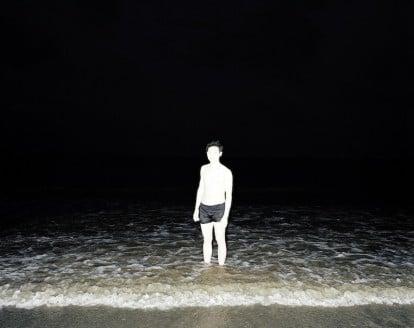Review: Flat Death, and exhibition of the work of Edgar Martins and Jordan Baseman
March 29, 2016

There is a strong connection between photography and mortality; photographs can be a startling and painful representation of a person who no longer exists. With this exhibition by Edgar Martins and Jordan Baseman we have a direct link between photography and death itself.
The works by Martins are of an abstract nature in their representations of death and suicide. The story of a suicide note written on a paper plane and thrown out of a prison is especially memorable. An issue for this reviewer is that what initially appeared to be censorship has reared its head. The curator has decided not to show certain pictures for safeguarding purposes and this made the exhibition seem incomplete. One can’t help feeling that a bolder approach would have been to include a warning on entering the gallery of potentially distressing content. With the subject matter of death should the artist’s vision really be diluted? Are potential visitors likely to expect something inoffensive? Like with any other art form I’m of the view that something should be shown completely as intended or not at all. This certainly doesn’t devalue the work that was shown, but I’d have preferred to have seen all of it.
*Since writing this review, Open Eye’s executive director Sarah Fisher and curator Thomas Dukes did explain their decisions at a discussion at Open Eye on 24th March – more on that later.
Far starker was the work by Jordan Baseman which includes a selection of funereal pictures of embalmed bodies including children. The idea is to show the link between portrait photography and embalming which share a purpose of creating a pleasant image and memory. The material is shown as a slide show in a quiet and dark room and is tastefully done.
The whole exhibition is pragmatic and unsentimental which made it interesting rather than mawkish. Also, the Open Eye has taken a socially responsible approach with supportive materials available from mental health agencies. The free exhibition brochure includes an interesting interview with Thomas Dukes and Angela Samata who sits on the suicide prevention All Party Parliamentary Group.
Overall, this is an interesting exhibition; it should provoke discussion on the arts’ representation of death and whether they can contribute to the breaking of this enduring taboo.
An extra dimension was added to this exhibition in a discussion chaired by Angela Samata (who recently made the ‘Life After Suicide’ programme for BBC1) and The Open Eye’s Thomas Dukes and Sarah Fisher. This was a fantastically provocative event which touched on huge themes such as the responsibility of the artist and curator towards their audience. Is a warning adequate when material has been assessed as potentially harmful by mental health experts? Would omitting strong material increase the risk of harm due to the audience not being sufficiently shocked by the horror of suicide? Sarah Davies informed us that they had been professionally advised against showing pictures of suicide implements as they could give vulnerable people ideas. It’s hard not to sympathise with Open Eye to an extent as they could have suffered huge repercussions of having discarded this advice if an incident had occurred. On whether the exhibits were right to be excluded, my views were best expressed by the words of a fellow participant: “we just don’t know, because we haven’t seen them – and that decision was made FOR us!”.
This discussion became bigger than the exhibition (which is very good) and could have lasted hours. My head was reeling with thoughts of Frank Zappa’s views on censorship, Fahrenheit 451, and Hitler’s condemnation of modernist composers like Arnold Schoenberg as “degenerate”.
The Open Eye must be commended and challenging public debates on the arts should be far more frequent. With the wide variety of arts spaces in the North West there is no reason why they shouldn’t be.
Open Eye 15th Jan – 3rd April ’16. Discussion on 24th March 2016.

Comments